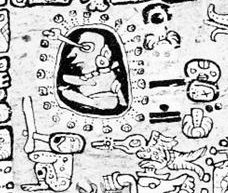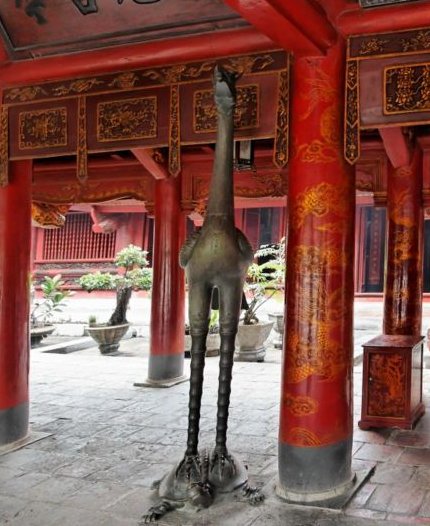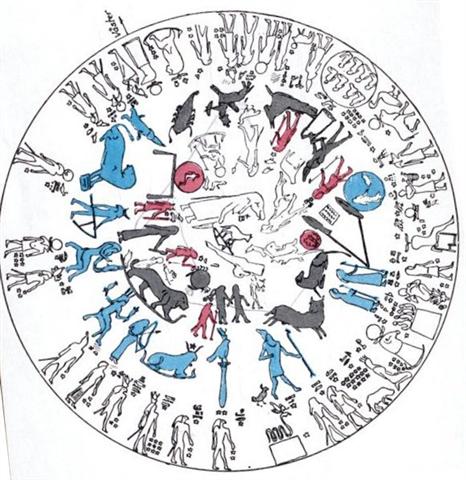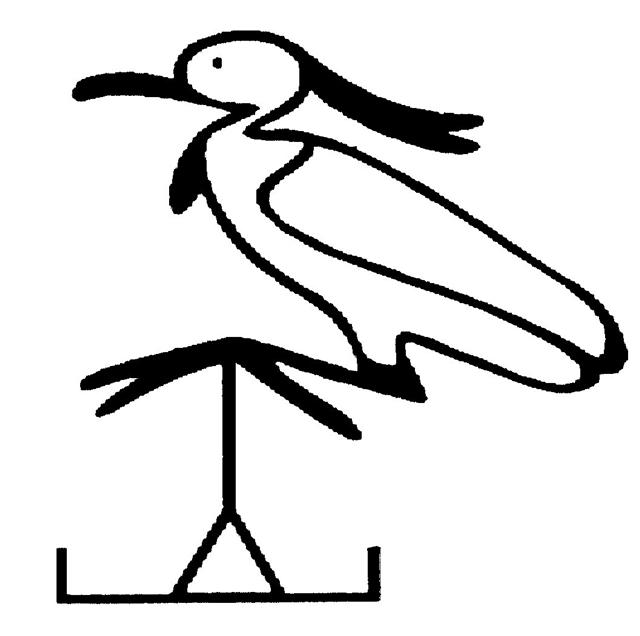4. We now can guess some of the meaning of the crane stretching high (standing in the Temple of Literature in Hanoi):
The star observer (the 'crane') is presumably stretching his neck to come closer to the stars, while the Mayan astronomer (cfr at The Mad Hatter) instead was using his eyes:  The Hanoi crane is presumably standing on the 'earth turtle' (Pawahtun, cfr at 2 Sticks): ... The higher placement of the North Building, with its 13 exterior doorways (reflecting the 13 layers of heaven), and the celestial serpents surmounting the huts identify it with the celestial sphere. The iconography of the West Building, with 7 exterior doorways (7 is the mystic number of the earth's surface), and figures of Pawahtun - the earth god as a turtle - indicate this to be the Middleworld, the place of the sun's descent into the Underworld. The East Building has mosaic elements reflecting the old war cult of Teotihuacan, where tradition had it that the sun was born; thus, this may also be Middleworld, the place of the rising sun. Finally, the South Building has 9 exterior doorways (the Underworld or Xibalba had 9 layers), and has the lowest placement in the compex; it thus seems to be associated with death and the nether regions.
The north corresponded to the high place, to the sky. The south corresponded to the low place, below the surface of the earth. In between was the Earth Mother, similar to how a turtle lives between its upper and lower shells. Grus ought to be of special interest for star observers, maybe because water once rushed down from holes in the sky causing a deluge: ... Now the deluge was caused by the male waters from the sky meeting the female waters which issued forth from the ground. The holes in the sky by which the upper waters escaped were made by God when he removed stars out of the constellation of the Pleiades; and in order to stop this torrent of rain, God had afterwards to bung up the two holes with a couple of stars borrowed from the constellation of the Bear. That is why the Bear runs after the Pleiades to this day; she wants her children back, but she will never get them till after the Last Day ... The round Dendera zodiac is in general in quite good agreement with the Babylonian zodiac, we have seen, but there is one fundamental difference - in the Dendera zodiac the domain in winter ruled by Aquarius does not show how the Milky Way inundates the 'earth' (the ecliptic path of the planets):
The reason, I think, is that the Nile (which corresponds to the Milky Way) was caused to rise by Sirius, at the opposite end of the sky. In Egypt the sacred landscape was upside down. The crane is a wader like the heron and long legs are useful when water covers the earth. I am reminded of the very first page in my outline glyph dictionary. The first of the glyph types is manu rere (which GD11 refers to):
It now can be added that the sign which the 'heron' is sitting on means 'darkness', caused by 'the black cloth' (cfr at Kuukuu):  And it can also be added that Grus has as an alternative name Flamingo (a name which sounds quite similar to that of the bird Phoenix), which obviously is based on 'flame'. Phoenicopterus (the Flamingo) is characterized by its red feathers. Wikipedia: ... from Greek φοινικόπτερος meaning 'purple wing'. Purple is the colour for kings and 'phoenix' should therefore mean 'purple, the colour of the king'.
Reading about flamingoes in Wikipedia I find a statement that 'many molecular and morphological studies support a relationship between grebes and flamingos'. This is rather surprising information, because it could explain why there is a grebe at the beginning of time: ... In the morning of the world, there was nothing but water. The Loon was calling, and the old man who at that time bore the Raven's name, Nangkilstlas, asked her why. 'The gods are homeless', the Loon replied. 'I'll see to it', said the old man, without moving from the fire in his house on the floor of the sea. Then as the old man continued to lie by his fire, the Raven flew over the sea. The clouds broke. He flew upward, drove his beak into the sky and scrambled over the rim to the upper world. There he discovered a town, and in one of the houses a woman had just given birth. The Raven stole the skin and form of the newborn child. Then he began to cry for solid food, but he was offered only mother's milk. That night, he passed through the town stealing an eye from each inhabitant. Back in his foster parents' house, he roasted the eyes in the coals and ate them, laughing. Then he returned to his cradle, full and warm. He had not seen the old woman watching him from the corner - the one who never slept and who never moved because she was stone from the waist down. Next morning, amid the wailing that engulfed the town, she told what she had seen. The one-eyed people of the sky dressed in their dancing clothes, paddled the child out to mid-heaven in their canoe and pitched him over the side. He turned round and round to the right as he fell from the sky back to the water. Still in his cradle, he floated on the sea. Then he bumped against something solid. 'Your illustrious grandfather asks you in', said a voice. The Raven saw nothing. He heard the same voice again, and then again, but still he saw nothing but water. Then he peered through the hole in his marten-skin blanket. Beside him was a grebe. 'Your illustrious grandfather asks you in', said the grebe and dived. Level with the waves beside him, the Raven discovered the top of a housepole made of stone. He untied himself from his cradle and climbed down the pole to the lowermost figure ...
You need to be sharp as a knife to understand it, though. |






